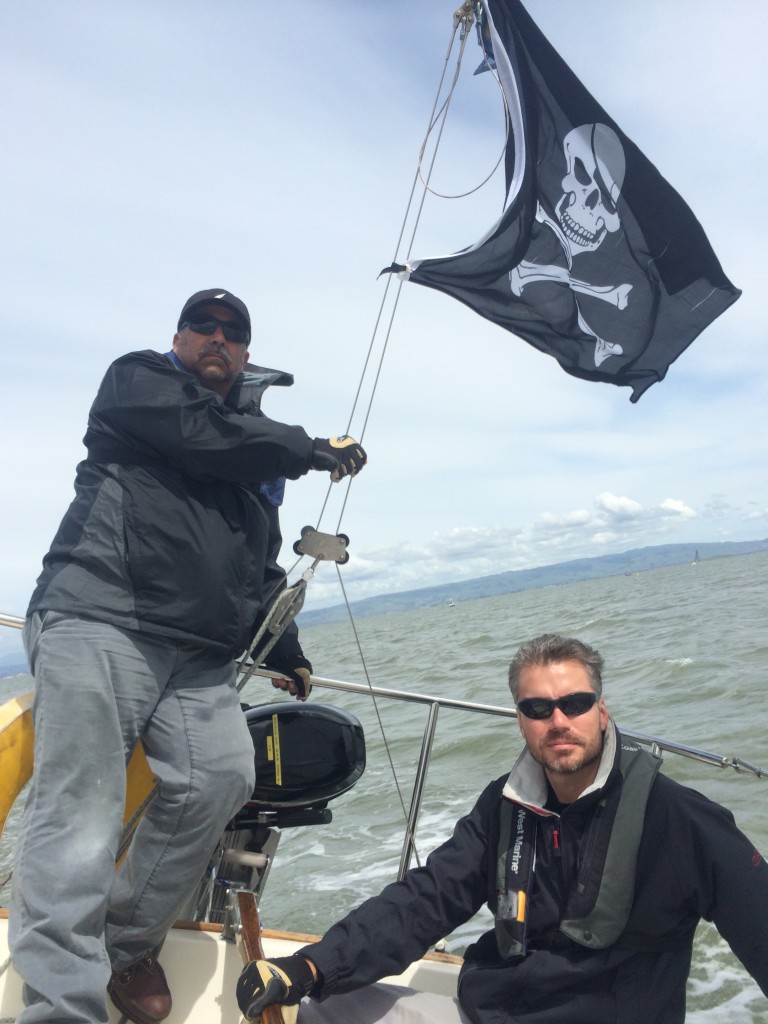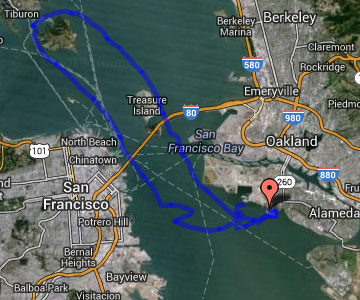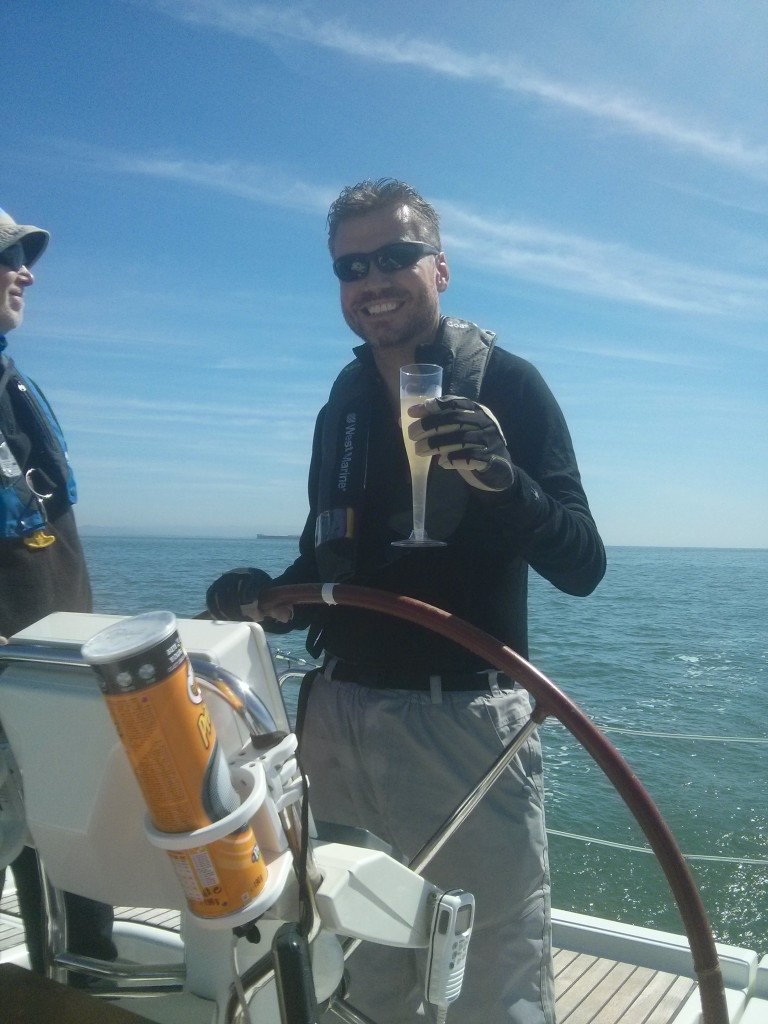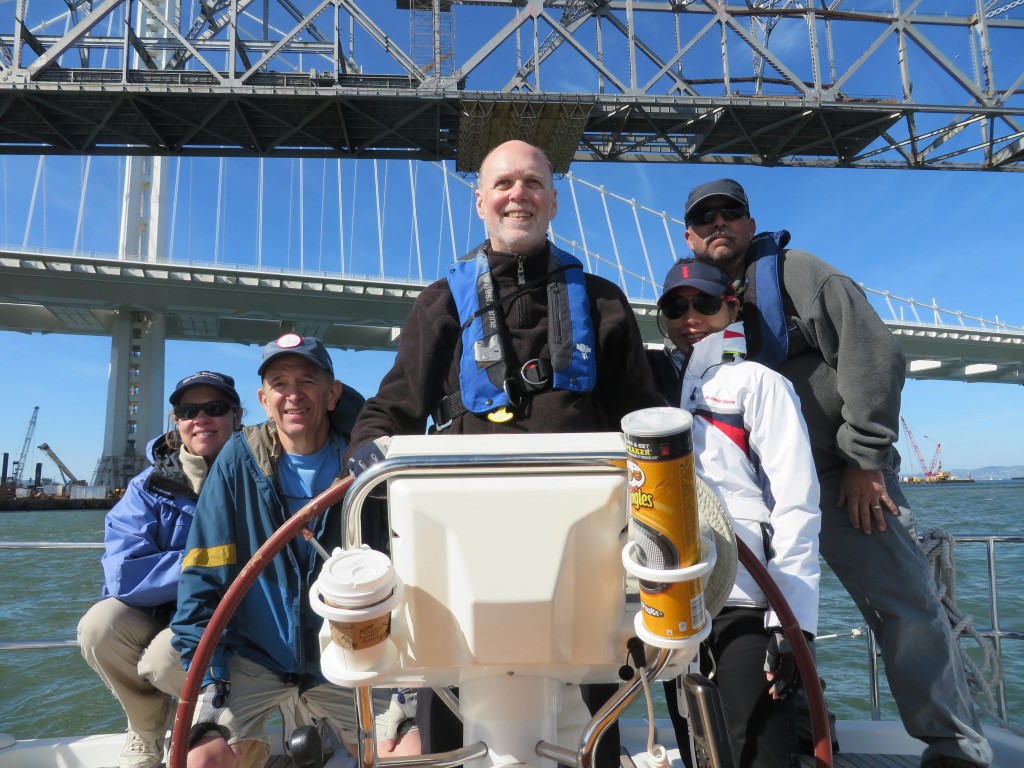Lady Washington and the Hawaiian Chieftain taken. There be bounties on their heads…
Sunday, March 16, 2014, Beneteau 37, Alameda to Angel Island
Steve’s Track:
Lloyd’s Track:
Steve W. and Jason carpooled with Steve M. to sail on a Beneteau 37 out of Ballena Bay on Alameda, along with Amy, Jason’s coworker Lloyd and his wife Sylvia. The Beneteau is a much more luxurious craft than we’re accustomed to, so it was a real treat to be able to do it, entirely due to Lloyd’s generosity.
Our experience with inboard cruisers is mostly with Catalina 27s. Jason sailed on a Beneteau 43 in Sardinia, so he was more familiar with the equipment. But Steve and Steve had only a few outings on the Catalinas, with their atrocious prop walk and clunky handling in swells. By comparison, the Beneteau is smooth and simple.
Except for the in-mast furling, which is a huge pain. In Sardinia, Jason’s boat had lazy jacks. Raising the main with the halyard was work, he says, but nothing compared to the effort to either raise (unfurl) or reef (furl) the main on Sunday’s boat. Either operation required the use of the winch, and was impossible unless the mainsheet was loose and the sail flogging madly. Reefing the main on a starboard tack, sailing under the jib with the main luffed, the furler must pull the main in around the starboard slot on the mast, so there’s a lot of friction, and it can’t be good for the sail. Plus, the furler jammed twice. I think we’d all happily stick to traditional bolt rope and halyard, thanks.
We motored out of Ballena Bay, through a narrow, shallow channel next to the breakwater. The Beneteau’s draft is about 6.5 feet. At high tide, the depth meter showed several feet under the the keel. (It was much less when we got back!) Then Lloyd instructed us to line up a flagpole on Ballena Boulevard with the Hunter’s Point derrick to track a safe course between banks to deeper water, and handed the helm over to Jason. That’s when the party started. Lunch came out. Amy had made delicious green pistachio and blue/yellow passion fruit macarons for everyone! Suddenly the helmsman had one of these in his hand:
Of course he didn’t drink it, preferring to keep it classy with the Paprika Pringles imported from Switzerland. It was great being able to eat a civilized lunch on deck with the nice fold out tables and little roll from the boat.
Then we got the sails out and turned toward San Francisco, sailing quite close to several large container and cargo ships at anchor. Lloyd explains that ships with a tendency to explode (oil and grain) anchor well out in the bay for safety.
The wind was very light until we sailed under the west span of the bay bridge. Amy took the wheel, and immediately the wind picked up, and continue to increase as we sailed east of Alcatraz. and soon we were heeled well over in 20-knot wind, with plenty of chop. But the boat continued to sail solidly, where the boats we’re used to would have been slamming through the water hard.
I took over at the wheel as we sailed toward the west side of Angel Island. The sailboat traffic increased until we were constantly calling out boats to each other and strategizing how to safely avoid collisions. A lug-sailed schooner slowly passed upwind of us, so we headed downwind slightly to give room, then headed up to cross behind and follow. Several boats approached from downwind, close-hauled, trying to gain offing from the lee shore of Angel, so we gave way to them, too.
As we passed close by the west shore of Angel, the wind died down and started shifting around, naturally. As we turned the corner to sail down Racoon Strait on a port tack, a smaller boat to our left decided to jibe to a starboard tack, then called out “Starboard! Starboard!” Effectively, they took the right of way so they could force us to jibe in toward the nearby shore. Thanks, guys. We did jibe, but before things got too tight, they jibed again, and we were able to follow and head up a bit to get behind them.
But the traffic was getting even more busy, so we started the motor, turned back head to wind, southwest by that time, furled the sails, and then Steve M. took the wheel to motor down Racoon Straight and then back toward Oakland along the east shore of Angel with basically no wind at all.
But soon we motored out of Angel’s shadow and into the main shipping channel, and the wind started to pick up again. So once again we winched out the main and unfurled the jib. Steve W. took the wheel, and we sailed in winds up to 20 knots past the north end of Treasure Island and under the twin east spans of the Bay Bridge. We noticed the upper deck of the old bridge is largely gone, and a few segments of the lower deck as well.
In the lee of Treasure Island, we were becalmed again, so we furled everything, and Lloyd’s wife Sylvia took the wheel to motor past the disused Alameda runways and the breakwater of the former Alameda Naval Air Station Channel.
Steve W. asked to practice backing the Beneteau, so he took the wheel and motored through the small gap in the breakwater into the harbor and then turned east toward nearby Marker 8, as a fixed reference point. A strong west wind had returned and persisted even inside the breakwater, so Steve didn’t feel safe backing downwind toward the marker in an unfamiliar boat. Instead, he motored past the marker, then twice backed slowly upwind to within a couple of boat lengths of the marker.
Steve then motored back out the gap in the breakwater and toward Ballena, everyone watching closely several other boats apparently headed for the same destination. Since it was nearly low tide by that time, we tried to let a couple of boats pass, so we could follow them past the banks instead of leading the way. But one slowed to a stop and the other turned back out toward the bay, so we were on our own as we tracked in on the flagpole, the depth gauge indicating less and less clearance, until finally it got down to 1.8 feet below the keel as we motored slowly up the breakwater.
Inside the Ballena Bay harbor, it’s a bit deeper, so we relaxed as Steve motored back up the channel. Lloyd pointed out our fairway, but Steve mistook the slip until too late, and the wind was blowing out of the slip, so by the time he tried to turn in, it was too late. A burst of power in reverse stopped the boat with the bow a few feet from the starboard dock piling, and a little more reverse backed us across the fairway and turned the boat to point back to the slip at an angle. A little power in forward but the slip on the starboard quarter, so Steve was able to turn to point straight into the slip on the second try. Lloyd stayed aboard with Steve as we put-putted into the slip and the other four stepped off each with one dockline. Steve shifted to idle a little too soon, so the boat drifted back out of the slip slightly before the springlines could be secured, but with so many crew it was easy to man-handle the boat back into position against the light wind.
We were on the water for about 5.5 hours and covered 28 nautical miles at 4.2 knots. The weather was unseasonably warm, the boat solid and smooth enough to eat lunch and sip cocktails. A perfect day, but for that furler!
Sunday, February 2, 2014
View 2/2/2014 11:31am in a larger map
Amy, Jason, Jim, and I took only a short sail yesterday. It was around 50F, but there was light rain off and on, so we got quite cold and headed back in by about 3 pm.
Despite being cold, we had a good time. It was interesting to see such variable conditions, lots of dramatic clouds and a little blue sky. I really need to bite the bullet and buy that foul weather gear!
The wind was from the south at first, quite strong, so we sailed downthe channel at about 6 knots, with no tacking. There were swells from the south, opposite the usual direction, as we headed in the direction of the red barrel, which we never did see.
We turned around and sailed back up the channel, with only one tack, until the wind died under the powerlines. We drifted with the flood current for awhile, then started the engine and motored back out of the channel until the wind returned around Marker 7.
At Marker 3, we turned around again, and again the wind died right around the powerlines, so we motored back to the dock.
We were on M-9, which Mike says the beer can racers fight over as the fastest. I can’t speak to that, but all the equipment worked, and it has cushions in the cabin, so it’s a good boat to choose if you’re going out. The motor mount is a different type from many of the others. It lifts the motor very high out of the water. Just be sure to raise the trapezoid mount before tilting the engine.
Amy, thanks for coming down from San Francisco. Jim, thanks for the ride back to the train station!






